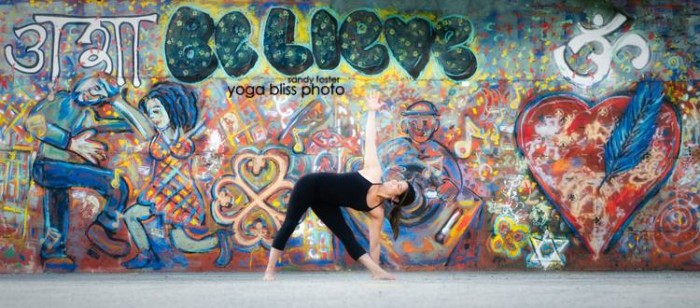I don’t teach anything spiritual in my yoga classes.
I don’t feel the need to, and I have no personal interest, although I am curious and have an intellectual interest in religion and spirituality. I haven’t had a spiritual experience in a yoga class in years, although I used to in the early years of taking yoga classes.
I can tell you why I had those experiences:
It’s because I believed the myth that “postural yoga” (the usual yoga class you’d take at a gym or yoga studio that focuses on stretching and strength-building poses) is a spiritual practice.
Now, through reading and research, I hold the position that the postural yoga practiced today is not a spiritual or religious practice in and of itself. It’s just a way to make your body healthy.
I learned this in a book titled “Yoga Body: The Origins of Modern Posture Practice” by Mark Singleton. Singleton tells us how through his research he discovered that many of the poses students reverently practice in yoga classes every day are nothing more than 100-year-old gymnastic poses. True, the hundreds of yoga poses available were practiced and mastered by famous Indian yogis, T. Krishnamacharya, Sri K. Pattabhi Jois, and B.K.S. Iyengar (the latter two being students of Krishnamacharya), but they practiced these poses mainly because they were taught as gymnastics in the British army. We’ll leave off the history there, but suffice it to say, trikonasana (triangle pose) is not 5,000 years old.
When considering why we practice postural yoga and what we get out of it spiritually, I believe we should focus on how taking care of our bodies effects our mental, emotional, and spiritual well-being.
Many people go through their days suffering physical ailments and pains. This physical experience can create emotional, mental, and spiritual suffering. It can be so distracting simply to suffer physically that one doesn’t even have the energy to think about the existential experience.
On the other hand, if the physical body is well, pain-free and resistant to illness, then the emotional, mental and spiritual experience—that is, the existential experience—can develop and deepen, perhaps beyond the physical body.
In my classes, I teach students to be aware of how their body feels in a pose, what their breathing sounds like, and how much is too much when working on more challenging poses. I don’t teach anything spiritual because I don’t want to and I don’t need to. When your body feels better and healthy, you can be a better, kinder, more patient person.
My contribution to the world through teaching yoga is making people feel healthier, (hopefully) happier and more in tune with their bodies so that they can have a better physical experience in the world. It is not through aligning your chakras (though if you feel like that happened in my class, that’s okay too).

Relephant Read
Meditation Science: How Yoga Induces Spirituality.
Author: Jennifer Fiorile
Apprentice Editor: Toby Israel / Editor: Renee Picard
Photo: Yoga Bliss Photo
Facebook is in talks with major corporate media about pulling their content into FB, leaving other sites to wither or pay up if we want to connect with you, our readers. Want to stay connected before the curtain drops? Sign up for our curated, quality newsletters below.







Read 2 comments and reply